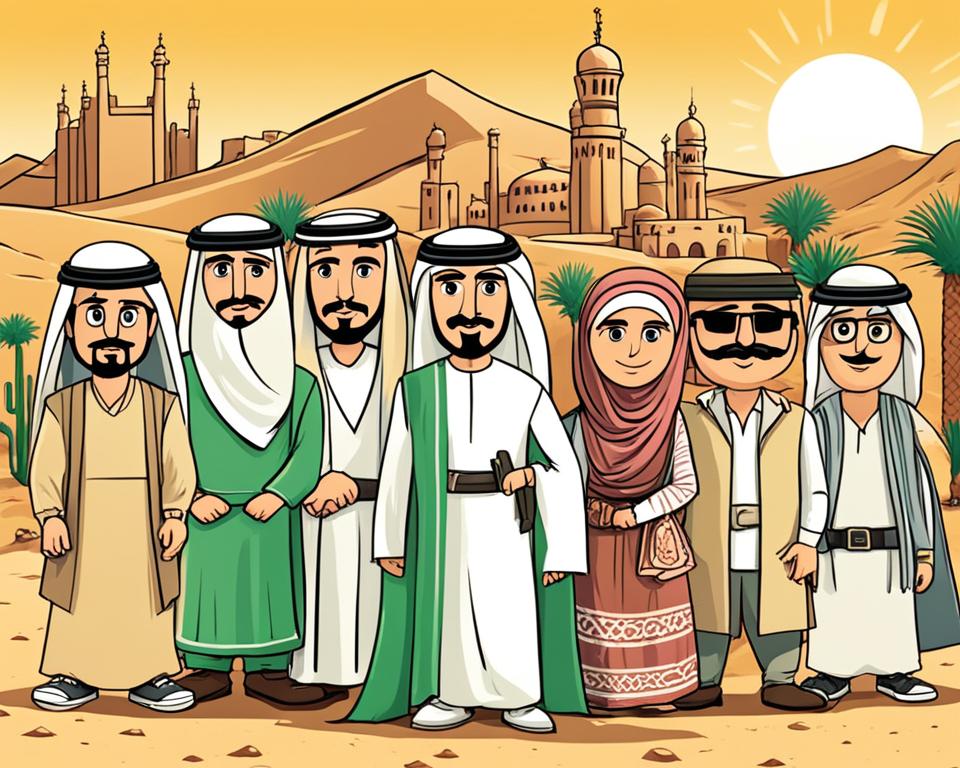Saudi Arabia has a rich film industry that is gaining recognition on the international stage. From captivating narratives to thought-provoking documentaries, Saudi Arabian cinema offers a window into the country’s culture, history, and transformation. Let’s explore a curated list of films set in and made about Saudi Arabia.
Key Takeaways
- Movies about Saudi Arabia provide insights into the country’s culture, history, and transformation.
- Saudi Arabian cinema encompasses a range of genres, including dramas, comedies, and documentaries.
- Notable films include “Architecture of Mud,” “Barakah Meets Barakah,” “Wadjda,” “One Day in the Haram,” and “The Kingdom.”
- These films offer a diverse perspective on Saudi Arabian society, from traditional architecture to modern romance.
- Exploring Saudi Arabia through movies allows audiences to gain a deeper understanding of its people and customs.
Whether you’re a cinephile or interested in expanding your cultural horizons, these movies about Saudi Arabia will take you on a captivating journey through this vibrant nation.
Table of Contents
Architecture of Mud (2006)
Architecture of Mud is a captivating Saudi Arabian film that explores the country’s rich architectural heritage. The movie dives into the beauty and significance of traditional mud-brick buildings that have shaped the landscape of Saudi Arabia for centuries.
The film takes viewers on a visual journey, showcasing the intricate craftsmanship and unique architectural styles found in different regions of the country. From the fortified mud-brick structures of the old town of Diriyah to the stunning mud-brick mosques of Najran, the movie highlights the importance of these structures in preserving Saudi Arabia’s cultural identity.
Directed by Abdullah Al-Eyaf, Architecture of Mud provides an in-depth exploration of the techniques, materials, and historical context behind these architectural wonders. Through stunning cinematography and compelling storytelling, the film offers a window into the past while celebrating the beauty and resilience of Saudi Arabian architecture.
The Inspiration Behind the Film
The concept for Architecture of Mud was born out of a deep appreciation for Saudi Arabia’s rich architectural heritage. The director, Abdullah Al-Eyaf, felt a strong desire to shed light on these traditional structures and their significance, not only as architectural marvels but also as symbols of the country’s cultural identity.
Al-Eyaf embarked on a journey to capture these buildings on film, visiting various regions of Saudi Arabia and collaborating with experts in the field of architectural preservation. Through meticulous research and attention to detail, Architecture of Mud serves as an homage to the craftsmanship and artistry that goes into constructing these mud-brick masterpieces.
The Impact of the Film
Since its release in 2006, Architecture of Mud has garnered critical acclaim both in Saudi Arabia and internationally. The film has not only brought global attention to Saudi Arabian cinema but also sparked a renewed interest in preserving and promoting the country’s architectural heritage.
By showcasing the beauty and historical significance of mud-brick buildings, the film has inspired a new generation of architects, historians, and cultural enthusiasts to appreciate and safeguard these architectural gems. It has also served as a catalyst for sustainable architectural practices, highlighting the eco-friendly nature of mud-brick construction.
Architecture of Mud stands as a testament to the power of cinema in capturing the essence of a nation’s culture and history. Through its cinematic portrayal of Saudi Arabia’s architectural legacy, the film invites viewers to rediscover the beauty and significance of these often-overlooked structures.
Barakah Meets Barakah (2016)
“Barakah Meets Barakah” is a delightful romantic comedy that offers a charming window into modern Saudi Arabian society and its evolving cultural landscape. Set against the backdrop of Saudi Arabia, this film follows the whimsical journey of Barakah, a young civil servant, and Barakah, a social media celebrity, as they navigate the complexities of love and relationships in a conservative society.
Directed by Mahmoud Sabbagh, “Barakah Meets Barakah” presents a refreshing and relatable portrayal of the challenges faced by young individuals in Saudi Arabia when it comes to romance. The film captures the nuances of societal norms and expectations while also highlighting the desire for freedom and self-expression.
Through witty dialogues and endearing performances, the film takes us on a heartfelt exploration of the protagonists’ blossoming relationship and their attempt to find happiness amidst traditional constraints. The struggles and triumphs they experience resonate with audiences, offering a glimpse into the universal search for love and connection.
With its universal themes and a touch of humor, “Barakah Meets Barakah” has gained international recognition and acclaim at film festivals worldwide. It has contributed to the growing visibility of Saudi Arabian cinema and exemplifies the talent and creativity emerging from the region.
Here is a list of noteworthy aspects in “Barakah Meets Barakah”:
- Refreshing portrayal of modern Saudi Arabian society
- Absorbing depiction of love and relationships
- Insightful exploration of societal expectations
- Engaging performances that bring the characters to life
- Thought-provoking commentary on social media and its impact
This film has left a lasting impression on audiences worldwide, contributing to the growth and recognition of Saudi Arabian cinema on the international stage.
Wadjda (2012)
“Wadjda” is a groundbreaking film directed by Haifaa al-Mansour, the first female Saudi Arabian filmmaker. It tells the captivating story of a young girl named Wadjda who dreams of owning a bicycle in a society where women’s rights are restricted. Through her determination and resilience, Wadjda challenges societal expectations and cultural norms, inspiring viewers with her unwavering spirit.
Set in Saudi Arabia, “Wadjda” offers a unique glimpse into the complexities of life in the country, shedding light on the challenges faced by women and the pursuit of individual dreams. The film beautifully captures the essence of Saudi Arabian cinema, showcasing the talent and creativity of the local film industry.
The film received critical acclaim both domestically and internationally, becoming the first Saudi Arabian entry for the Best Foreign Language Film category at the Academy Awards. Its powerful storytelling and compelling performances have made a significant impact, not only within the realm of Saudi Arabian cinema but also in global cinema.
| Key Details | Information |
|---|---|
| Director | Haifaa al-Mansour |
| Release Year | 2012 |
| Genre | Drama |
| Runtime | 98 minutes |
| Language | Arabic |
| Awards and Nominations |
|
“Wadjda” stands as a testament to the resilience of individuals striving for change, even in the face of adversity. It has made a significant impact on Saudi Arabian cinema, contributing to a broader representation of diverse stories and perspectives. Through its powerful storytelling and remarkable performances, “Wadjda” has firmly established itself as a milestone in the history of Saudi Arabian films.
One Day in the Haram (2017)
“One Day in the Haram” is a captivating documentary that immerses viewers in the extraordinary world of the Great Mosque of Mecca, also known as the Haram. This remarkable film allows audiences to experience the annual pilgrimage to Mecca, showcasing both the cultural and religious significance of this sacred site.
Through stunning cinematography and intimate storytelling, “One Day in the Haram” offers a unique glimpse into the rituals, traditions, and profound moments that unfold within the Haram’s hallowed grounds. From the grandeur of the Kaaba to the devotion of the pilgrims, the documentary captures the essence of this spiritual journey.
By exploring the rich tapestry of Saudi Arabia’s culture and showcasing the power of faith, this film not only sheds light on the significance of the Hajj pilgrimage but also deepens our understanding of the Kingdom’s cultural heritage. “One Day in the Haram” is a testament to the beauty and reverence found within Saudi Arabia’s diverse and vibrant society.
Exploring the Grandeur of the Great Mosque
The documentary takes viewers on an awe-inspiring virtual tour of the Haram, offering a glimpse into its magnificent architecture, intricate designs, and spiritual significance. From the bustling courtyard to the serene prayer halls, each corner of the Haram tells a story of devotion and unity.
Capturing the Journey of Pilgrims
“One Day in the Haram” intimately follows the personal narratives of pilgrims from all walks of life as they embark on this transformative journey. The film captures their emotions, struggles, and moments of profound connection, allowing viewers to witness the power of faith and the bonds that unite humanity.
Preserving Saudi Arabia’s Cultural Heritage
This documentary serves as a valuable contribution to the preservation and celebration of Saudi Arabia’s rich cultural heritage. By showcasing the Hajj pilgrimage and its deep-rooted traditions, “One Day in the Haram” highlights the importance of cultural preservation and cross-cultural understanding.
Impact of “One Day in the Haram”
“One Day in the Haram” has not only enlightened audiences around the world about the significance of the Hajj pilgrimage but has also played a pivotal role in promoting Saudi Arabian cinema on the global stage. The film’s compelling narrative and stunning visuals have captivated viewers, fostering a deeper appreciation for Saudi Arabia’s rich culture and history.
The Kingdom (2007)
“The Kingdom” is an action thriller film set in Saudi Arabia. Released in 2007, the movie follows a team of US government agents who are sent on a mission to investigate a devastating terrorist attack on an American facility in Riyadh, the capital of Saudi Arabia.
The film not only provides an adrenaline-pumping story but also offers a unique portrayal of Saudi Arabia on screen. It brings viewers into the heart of the Kingdom, showcasing its vibrant culture, stunning landscapes, and the striking juxtaposition of traditional elements with modern architecture.
“The Kingdom” delves deep into the complexities of working in a foreign country, highlighting the challenges faced by the American agents as they navigate cultural differences, language barriers, and bureaucratic obstacles. It sheds light on the importance of international cooperation and the intricacies of diplomatic relations.


